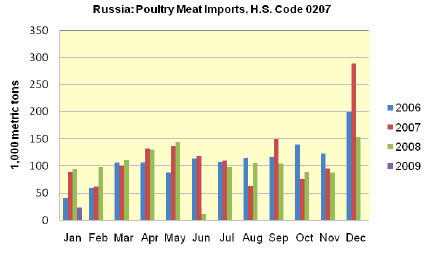



International Egg and Poultry Review
US - By the USDA's Agricultural Marketing Service (AMS). This is a weekly report looking at international developments concerning the poultry industry. This week's report is about the poultry situation in Russia.Russian Meat and Poultry Prices
Inflation rose 13.3 per cent in 2008 according to the Russian State Statistic Service (Rosstat), much higher than the Russian government’s forecast of 7 per cent. January 2009 inflation rose 2 per cent, with most of the increase attributed to the increase in meat and poultry products. Average food prices rose nearly 18 per cent in 2008 while average retail prices for meat and poultry increased by more than 23 per cent. Disposable income only grew 2.7 per cent in 2008, compared to a 12.1 per cent increase in 2007. During the last six months the Russian ruble decreased by 35 per cent against the US dollar (1 USD = 23 Rubles in Sep 2008 compared to 36 Rubles in March 2009), making imported goods much more expensive.
About 30 per cent of total poultry and meat retail trade takes place at open air markets. Ministry of Agriculture officials have been planning for many years to develop a system of cooperative farmers markets to make the distribution chain shorter and thus allow customers to buy lower priced meat and other food items. Under this plan agricultural products would go straight from the field/farm to farmers markets and would be traded by farmer’s representatives, avoiding the retailers.
Some experts expect that consumers may begin buying more in traditional markets than in supermarkets. In view of the economic crises the Moscow city government decided to suspend its program targeted at decreasing the number of kiosks, booths, stands and truck-bed kiosks. Originally they planned to close 1,500 trade kiosks in 2009, 20 per cent of the total number.
Ministry of Agriculture officials publically vowed to limit meat and poultry imports in order to protect domestic meat and poultry producers during the global financial crises. A major cause of concern of Russian government officials is the ability of new pork and poultry producers to repay their subsidized loans financed under the National Priority Project for Agriculture.
Imports of meat and poultry suffered steep declines in the fourth quarter with December sales falling to a fraction of historic averages. The majority of declines can be attributed to the cancelling of contracts due to importers’ inability to obtain credit and the plummeting ruble which has made imports significantly more expensive.
Higher beef and pork prices will likely result in consumers turning to less expensive poultry meat and eggs.

Source: Russian Customs Foreign Trade Statistics
The price gap between wholesale domestic and imported leg quarters generally hovered around 10 Rubles/kg in the first half of 2008 and fell to between 3-6 Rubles/kg in the second half of 2008.

Between December 2007 and December 2008 retail prices for frozen whole chicken increased 24 per cent in Moscow open-air markets, but fell 2 per cent in Moscow hypermarkets. Retail prices for frozen pork jumped 45 per cent in open air and 15 per cent in hypermarkets while beef rose 15 per cent in open air markets and 10 per cent in hypermarkets.

Tariff-rate quotas on beef, pork and poultry meat imports for 2009 were modified after Russian officials held consultations with major trading partners in late 2008. The duty on poultry imports exceeding the quota increased to 95 per cent but not less than 0.8 Euros per kilogram. The previous rate was 40 per cent but not less than €0.32/kg. The over quota duty on chilled and frozen beef was lowered to 30 per cent, but not less than €0.30/kg. Pork was increased to 75 per cent and but not less than €1.5/kg (previously 45 per cent and €0.55/kg).
A conference titled, “Regime of Meat Imports Regulation for 2010 and Following Years,” took place in late January 2009 and was headed by Minister of Agriculture Aleksey Gordeyev. Participants included representatives of the Russian Meat Union, the Union of Meat Suppliers, the Russian Poultry Union, the National Meat Association, the Russian Union of Pork Producers, the Russian Union of Industrialists and Entrepreneurs and the Association of the Russian Poultry Market Operators in a discussion on developing a new policy on meat and poultry imports after 2009. Gordeyev noted the necessity for “maintaining the current quota regime” which helps investors and market players better forecast the situation with more precision. At the same time Gordeyev believes that planning a TRQ distribution system should include all meat varieties and their volumes and should not be longer than a three year period (2010-2012).
“We need to establish such proportion of domestic and imported meat products that would enable us to resolve the issues of Russia’s food security with consideration of changing global economic situations and influences of the world financial crisis,” Gordeyev underlined.”
Source: USDA/Foreign Agriculture Service Attaché Reports
Further Reading
| - | You can view the full report by clicking here. |











